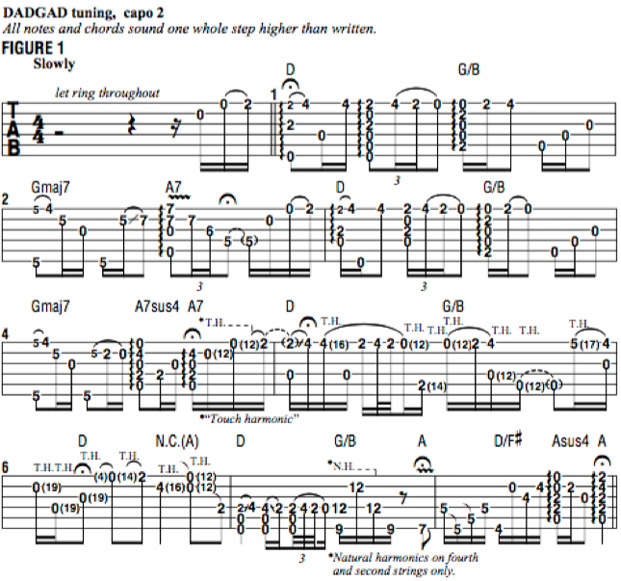Creative Ways to Incorporate Harmonics, and How to Play “Somewhere Home”

For my original composition “Somewhere Home,” which appears on What Just Happened, one objective was to investigate musically creative ways to weave the sound of harmonics into the composed melodies.
For review, a natural harmonic (N.H.) is produced by lightly touching a string with a fretting finger directly above a specific location, called a node, the most prominent nodes being directly above the 12th, seventh and fifth frets. When the string is picked, a chime-like sound is produced, which continues to ring even if the finger is lifted off the string.
If one were to lay a fret-hand finger lightly across all six strings at any of the aforementioned nodes, as if you were barring, but without pushing the strings down to the frets, one could strum the strings to produce six harmonics that will ring together.
A natural harmonic may also be performed entirely with the pick hand. Lightly touch the string at one of the nodes with the tip of the index finger and then pick the string with the thumb, middle finger or ring finger. This technique is sometimes referred to as a “touch harmonic” (indicated by the abbreviation T.H.). The beauty of it is that it frees up the fret hand completely, which may then be used to perform a second, independent part.
For “Somewhere Home,” my guitar is tuned to DADGAD (low to high: D A D G A D), with a capo on the second fret. As is usually the case when using a capo, I think of the pitches as “transposing,” meaning I will refer to notes and chord names as if the capo were not in use. For example, with the capo on the second fret, picking the open first string produces a concert pitch E, but I think of this note as D, as if the capo wasn’t there. For most players, thinking this way helps with the recognition of chord shapes.
FIGURE 1 illustrates the first eight bars of the song. There is a pick-up bar before bar 1, and here I strike the open top two strings, followed by a hammer-on up to the second fret on the first string, setting up the introduction of the D major chord on beat one of bar 1. For this first chord, and for many of those that follow, I use a “rolling” technique with the pick hand, arpeggiating the high strings from low to high. This first chord is sounded with the thumb, index and middle fingers, but for the D chord on beat two, the pick-hand thumb is dragged across all of the strings.
It is not until the very end of bar 4 that I bring touch harmonics into play, in each case lightly touching the string with the tip of my pick-hand index finger while picking it with the middle finger. Notice that I utilize hammer-ons in conjunction with the technique. As I progress through bars 5 and 6, touch harmonics are produced either in this manner or with the use of a pull-off in place of picking a given string. When sounding a harmonic with a fretted note, be sure that the “touching” index finger is positioned exactly 12 frets up from the fretted note.
This is a complex piece, so I encourage you to work through each bar slowly and carefully, with great attention to detail. For me, bringing these kinds of techniques into my playing style widens my sonic palette in a myriad of ways, and I encourage you to experiment with them in your own playing and composing.
Wood Vibrations November 2016 FIGURE 1

Get The Pick Newsletter
All the latest guitar news, interviews, lessons, reviews, deals and more, direct to your inbox!
“There are so many sounds to be discovered when you get away from using a pick”: Jared James Nichols shows you how to add “snap, crackle and pop” to your playing with banjo rolls and string snaps
Don't let chord inversions bamboozle you. It's simply the case of shuffling the notes around







![Joe Bonamassa [left] wears a deep blue suit and polka-dotted shirt and plays his green refin Strat; the late Irish blues legend Rory Gallagher [right] screams and inflicts some punishment on his heavily worn number one Stratocaster.](https://cdn.mos.cms.futurecdn.net/cw28h7UBcTVfTLs7p7eiLe.jpg)


